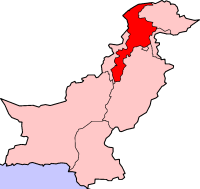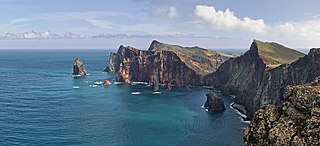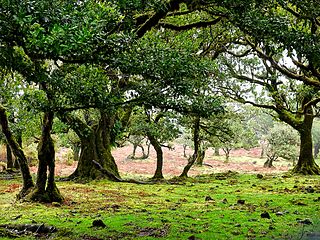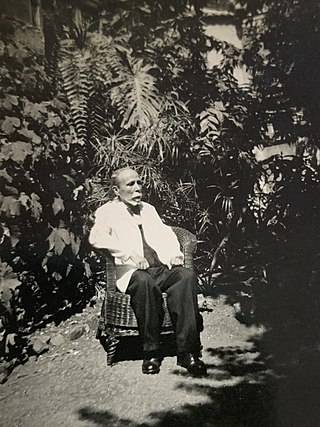
Madeira, officially the Autonomous Region of Madeira, is one of two autonomous regions of Portugal, the other being the Azores. It is an archipelago situated in the North Atlantic Ocean, in a region known as Macaronesia, just under 400 kilometres (250 mi) to the north of the Canary Islands and 520 kilometres (320 mi) west of the Kingdom of Morocco. Madeira is geologically located on the African Tectonic Plate, although it is culturally, politically and ethnically associated with Europe, with its population predominantly descended from original Portuguese settlers. Its population was 251,060 in 2021. The capital of Madeira is Funchal, which is located on the main island's south coast.

The trocaz pigeon, Madeira laurel pigeon or long-toed pigeon is a pigeon which is endemic to the island of Madeira, Portugal. It is a mainly grey bird with a pinkish breast; its silvery neck patch and lack of white wing markings distinguish it from its close relative and probable ancestor, the common wood pigeon. Its call is a characteristic six-note cooing, weaker and lower-pitched than that of the wood pigeon. Despite its bulky, long-tailed appearance, this pigeon has a fast, direct flight.
The Madeira Football Association is the regional governing body for the all football competitions in the former Portuguese district of Funchal, including both Madeira Island and Porto Santo Island. It is also the regulator of the clubs registered in the autonomous region.

Clube Desportivo Nacional, commonly known as Nacional and sometimes Nacional da Madeira, is a Portuguese football club based in Funchal, on the island of Madeira.

The Madeiran wood pigeon was a subspecies of the wood pigeon endemic to Madeira (Portugal), and found in the island's laurel forest habitat.
Günther Edmund Maul was a German ichthyologist and taxidermist in Portugal. Maul came to Madeira in December 1930 to work as taxidermist at Museu Municipal do Funchal, which opened to the public in 1933. He was appointed director for the museum in 1940, a post that he held to his retirement in 1979. He, however, continued his research until shortly before his death. He started two journals and opened the museum's aquarium to the public in 1959. He also participated in several expeditions including with the French bathyscaphe Archimède in 1966 and organised the first multidisciplinary expedition to the Salvage Islands in 1963. He was awarded an honorary doctorate from the University of Madeira in 1995.

The genus Phallus, commonly known as stinkhorns, is a group of basidiomycetes which produce a phallic, often foul-scented mushroom, from which their name is derived. The genus has a widespread distribution and, according to a 2008 estimate, contains 18 species. They belong to the family Phallaceae in the order Phallales. The best known species is the common stinkhorn.

The Madeira pipistrelle is a species of vesper bat. It is endemic to Azores, Madeira and the Canary Islands.

Sorbus maderensis is a species of rowan in the family Rosaceae that is endemic to Madeira. It is threatened by habitat loss.

The Madeiran chaffinch is a small passerine bird in the finch family Fringillidae. It was formerly a subspecies of the common chaffinch, but is now generally considered to be a species in its own right. It is endemic to the Portuguese island of Madeira, part of Macaronesia in the North Atlantic Ocean. It is locally known as the tentilhão.

Phallus calongei is a species of stinkhorn mushroom. Found in Pakistan, it was described as new to science in 2009. Starting out as an "egg", the fully expanded fruit body consists of a single, thick, stipe with a cap attached to the apex and covered with olive-green, slimy spore-containing gleba. It is distinguished from other similar Phallus species by a combination of features, including a pinkish, reticulated (network-like) cap, and a stipe that is tapered at both ends. The edibility of the mushroom is unknown.
Hedera maderensis, the Madeiran ivy, is a species of ivy which is native to the Atlantic coast in Madeira island. It is a plant of botanical family Araliaceae, species endemic to the island of Madeira with the name: Hedera maderensis. Formerly a subspecies named Hedera maderensis iberica, one iberian subspecies in west Iberian peninsula was subsequently classified as a distinct species. It is quite common in Madeira and lives in slopes rock, soil, trunks of trees especially in Laurel forest of Barbusano.
Cyclophora maderensis is a moth in the family Geometridae. It is found on the Canary Islands and Madeira.
Johann Christian Albers was a German physician and malacologist.

The Madeira rockfish is a species of scorpionfish (Scorpaenidae) in the genus Scorpaena, found in the coastal waters of the eastern Atlantic Ocean and the Mediterranean Sea. This species reaches a length of around 14 centimetres (5.5 in) SL. The species was described by Achille Valenciennes in 1833 after a specimen from Madeira. Although S. maderensis is well represented in the areas that it is found, many key aspects of its biology are still unknown.

Ponta de São Lourenço is the easternmost point of the island of Madeira. It is inside the town of Caniçal and forms a part of the municipality of Machico. Its terrain are made up of rocks and herbaceous vegetation. Since 1982, the headland is a nature reserve, where it has the conservation of its endemic plants including Matthiola maderensis, Echium nervosum, and Andryala glandulosa, and it has fauna, including birds, insects, and molluscs. One of them is Monachus monachus, a seal. Marine fauna are in the waters surrounding the headland.

The Madeira evergreen forests is a laurissilva ecoregion of southwestern Europe. It covers the archipelago of Madeira and some nearby islands in the Atlantic Ocean. Laurel forest, known as laurissilva, once covered the islands. Over centuries the laurel forests were mostly cleared. Madeira's remaining forests are now protected.

Adolfo César de Noronha was a Portuguese naturalist.
Filipe André Paula da Rocha, known as Filó, is a Portuguese former footballer who played as a centre-back, and a current manager.












